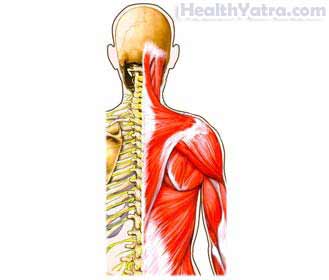সংজ্ঞা
A muscle strain is an injury (partial tear) that damages the internal structure of the muscle. The tearing may be so small that one could only see it with a microscope. However, the tearing could be severe enough to cause internal bleeding and cause some muscle fibers to lengthen. If the damaged parts of the muscle actually pull away from each other, it is called a muscle rupture.

কারণসমূহ
A muscle strain is caused by tension or stress applied to the muscle that it cannot withstand. There are several ways that this can happen:
- Muscle may not be ready for sudden stress
- Tension may be too much for the muscle to bear (such as, lifting a weight that is too heavy for you)
- Muscle is used too much on a certain day
Certain areas have muscles that are more likely to be strained than others including:
- Hamstrings
- কুঁচকি
- পেছনে
- Calf
Muscles that cross two joints are at risk.
ঝুঁকির কারণ
A risk factor is something that increases your chance of getting a disease or condition. Risk factors for a muscle strain include:
- Athletic activities, especially those with running and jumping
- Tight muscles
- ক্লান্তি
- অতিরিক্ত পরিশ্রম
- ঠান্ডা আবহাওয়া
লক্ষণ
Symptoms depend on how you strained the muscle.
Strain While Performing an Athletic or Physical Activity
You immediately feel soreness or pain in the affected muscle. If you try to use that muscle it hurts even more. The area becomes tender, and often has local swelling. In the most severe cases, there may be a skin bruise showing because of bleeding underneath. Moving the nearby joints causes pain. Running and lifting are common activities that cause this type of muscle strain.
Strain from an Accumulation of Stress
When you do an activity that your body is not used to doing, the muscles are not in shape for that kind of activity. There may not be one specific incident during the activity when you feel pain, but the next day a muscle or set of muscles may be very sore. The muscle will be tender, and using it causes pain or discomfort.
রোগ নির্ণয়
The doctor will ask about your symptoms, your recent physical activity, and how the injury occurred. The doctor will also examine the injured area for:
- Tenderness directly over the muscle
- Pain when contracting the muscle particularly against resistance
পরীক্ষা অন্তর্ভুক্ত হতে পারে:
- MRI scan—a test that uses magnetic waves to make pictures of structures inside the body (This is uncommon for most people. Usually this is done with college or professional athletes to determine when they will return to their sport.)
- আল্ট্রাসাউন্ড - একটি পরীক্ষা যা শরীর পরীক্ষা করার জন্য শব্দ তরঙ্গ ব্যবহার করে
- CT scan—a type of x-ray that uses a computer to take pictures of structures inside the body
চিকিৎসা
Treatment depends on the severity of the strain and the muscle involved.
Treatment usually includes:
- Rest—Do not do activities that cause pain. If normal walking hurts, shorten your stride. Do not play sports until the pain is gone.
- Ice—Apply cold to the injured area for 15-20 minutes, four times a day for several days after the injury. Do not apply the cold directly to the skin.
- Compression and elevation—This can decrease swelling.
- Oral nonsteroidal anti-inflammatory drugs (NSAIDs) to relieve pain and topical pain medicines (such as, creams, patches) applied to the skin—These medicines can also mask symptoms. If you still have muscle tenderness while taking these drugs, do not return to physical activity and check with your doctor.
- Heat—Use heat only when you are returning to activity. Then use it before stretching or getting ready to exercise.
- Stretching—When the acute pain is gone, start gentle stretching. Stay within pain limits. Hold each stretch about 10 seconds and repeat six times. Repeat stretching four times a day.
- Strengthening—When a muscle is injured, it becomes weaker because it is not used. You must gradually regain strength. It is best to do this under the supervision of a healthcare professional.
If you are diagnosed with a strained muscle, follow your doctor’s instructions.
প্রতিরোধ
To reduce your chance of straining a muscle:
- Keep your muscles strong so they can absorb the energy of sudden stressful activities.
- After a short warm-up period, stretch out tight muscles, especially previously injured ones.
- Learn the proper technique for athletic activities. This will decrease muscle stress.
- Stop when you are tired. Tired muscles do not function well. They do not react properly to sudden stress.
